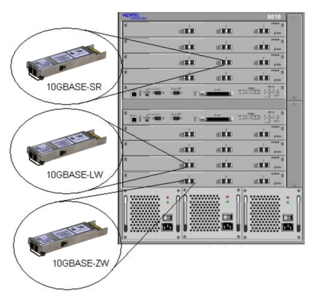
Back 10 Gigabit Ethernet Catalan 10-Gigabit-Ethernet German 10 Gigabit Ethernet Spanish 10-gigabitine Ethernet Estonian اترنت ۱۰ گیگابیتی Persian 10 Gigabit Ethernet French 10 gigabit Ethernet Italian 10ギガビット・イーサネット Japanese 10기가비트 이더넷 Korean 10 Gigabit Ethernet Dutch

10 Gigabit Ethernet (abbreviated 10GE, 10GbE, or 10 GigE) is a group of computer networking technologies for transmitting Ethernet frames at a rate of 10 gigabits per second. It was first defined by the IEEE 802.3ae-2002 standard. Unlike previous Ethernet standards, 10GbE defines only full-duplex point-to-point links which are generally connected by network switches; shared-medium CSMA/CD operation has not been carried over from the previous generations of Ethernet standards[1] so half-duplex operation and repeater hubs do not exist in 10GbE.[2] The first standard for faster 100 Gigabit Ethernet links was approved in 2010.[3]
The 10GbE standard encompasses a number of different physical layer (PHY) standards. A networking device, such as a switch or a network interface controller may have different PHY types through pluggable PHY modules, such as those based on SFP+.[4] Like previous versions of Ethernet, 10GbE can use either copper or fiber cabling. Maximum distance over copper cable is 100 meters but because of its bandwidth requirements, higher-grade cables are required.[a]
The adoption of 10GbE has been more gradual than previous revisions of Ethernet: in 2007, one million 10GbE ports were shipped, in 2009 two million ports were shipped, and in 2010 over three million ports were shipped,[5][6] with an estimated nine million ports in 2011.[7] As of 2012[update], although the price per gigabit of bandwidth for 10GbE was about one-third compared to Gigabit Ethernet, the price per port of 10GbE still hindered more widespread adoption.[8][9]
By 2022, the price per port of 10GBase-T had dropped to $50 - $100 depending on scale.[10] In 2023, Wi-Fi 7 routers began appearing with 10GbE WAN ports as standard.
- ^ Michael Palmer (21 June 2012). Hands-On Networking Fundamentals, 2nd ed. Cengage Learning. p. 180. ISBN 978-1-285-40275-8.
- ^ IEEE 802.3-2012 44.1.1 Scope
- ^ "IEEE P802.3ba 40Gbit/s and 100Gbit/s Ethernet Task Force". 21 June 2010.
- ^ Sharma, Anil (19 January 2011). "LightCounting forecasts CAGR of Over 300 Percent for 10GBASE-T Port Shipments Through 2014". TMCnet. Retrieved 7 May 2011.
- ^ "Dell'Oro press release". Archived from the original on 19 July 2011. Retrieved 29 March 2011.
- ^ "Intel blog about Interop 2011". Archived from the original on 25 May 2011. Retrieved 20 September 2011.
- ^ "Exclusive: Google, Amazon, and Microsoft Swarm China for Network Gear". Wired.
- ^ Morgan, Timothy Prickett. "10 Gigabit Ethernet still too expensive on servers". www.theregister.com. Retrieved 6 August 2023.
- ^ Pott, Trevor; Thomson, Iain. "Soz, switch-fondlers: Doesn't look like 2013 is 10Gb Ethernet's year". www.theregister.com. Retrieved 6 August 2023.
- ^ "10GBASE-T vs SFP+ Fiber vs SFP+ DAC: Which to Choose for 10GbE Data Center Cabling? | FS Community". Knowledge. 4 November 2015. Retrieved 6 August 2023.
Cite error: There are <ref group=lower-alpha> tags or {{efn}} templates on this page, but the references will not show without a {{reflist|group=lower-alpha}} template or {{notelist}} template (see the help page).